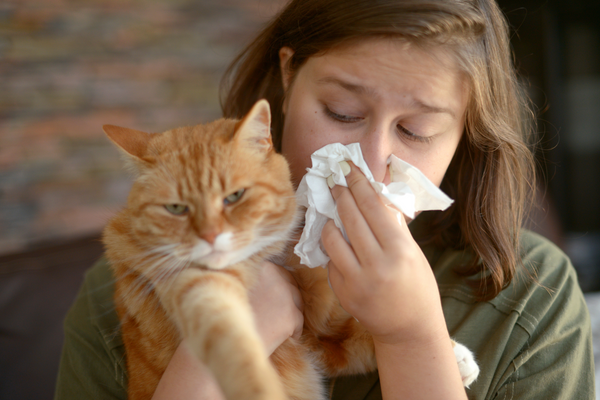The Ecology Works Guide for Pets and Owners with Allergies

Can I Have a Pet If I Have Allergies?
Approximately 20% of the world’s population suffers from allergies to dogs and cats, according to the Asthma and Allergy Foundation of America (AAFA.) However, this shouldn’t discourage most pet-allergic people from having animal companions. In fact, many experts agree that allergy sufferers can live happily with their pets.
Why exactly are you allergic to your pet? Surprisingly, it’s not their fur. However, their fur can be a reservoir for other allergens, such as dust mites, mold spores, pollen, etc.
Instead, cats and dogs have unique proteins in their saliva, sweat, urine, and skin that can trigger an allergic reaction in people. When sweat, saliva, and urine dry on your pet's fur, they form a coating called dander, which is a major allergen. The dander dries, cracks, and falls onto your carpet, furniture, and clothes. You can inhale or transfer it from your hands to your eyes and nose.
Cats and dogs give off different allergens; some people may be allergic to one and not the other. People can also exacerbate their allergies by exposure to high levels of other allergens and irritants like mold.
As the number of homes with pets keeps increasing, more people seek solutions to their sensitivity to pet allergens. Approximately 4.1 million animals are adopted from animal shelters annually in the U.S. Nearly 575,000 are returned to the shelter following adoption.
In a recent analysis of returned shelter animals in the U.S., incompatibility with existing pets and owner’s health concerns, particularly allergies, also leads to a significant number of returned adoptions. According to the report, 15% of adopted cats are returned to shelters because of allergic reactions. Sadly, previous research has found owners who relinquished animals due to allergies often view their situation as insurmountable.
Keeping owners and their pets living happy, healthy, full lives is one of the primary reasons The Ecology Works was founded. In many cases, symptoms of pet allergies can be managed with a holistic approach to prevention. Our products address the source of your allergies, not just symptoms. And while they are highly effective in neutralizing allergens, our products are formulated with people, pets, and the planet in mind.
Reducing the number of allergens in your home is a great place to start combatting your allergies. Still, some people may benefit from prescription medicine, allergy immunotherapy (allergy shots), or other treatments. Some with severe allergies and asthma may be discouraged from owning pets; however, most people can effectively manage their symptoms.
This guide covers all you need to know about managing your pet allergies.
What Animals Can Cause Allergic Reactions in People?
It’s easy to only think of dander and allergies when it comes to dogs and cats, but there is a whole world of pet allergy possibilities out there. Horses, rabbits, guinea pigs, cockatiels; pretty much every animal with fur or feathers has dander.
Another common misconception is that certain breeds of dogs and cats are hypoallergenic.
Unfortunately, this is not true. Although individual animals may stimulate fewer allergy symptoms in certain people than others, all dogs, cats, and other warm-blooded pets (and most birds) produce allergens.
Different allergens may vary between individual animals, but this is not due to a specific gender, breed, or breed mix. Some allergic individuals tolerate some breeds better than
others due to variations in the amounts and types of allergens produced. However, despite advertising claims and higher prices, no animals are truly free from allergens.
Pet allergens can be carried on hair that is shed into the air or on home surfaces, so that may be why some people are less sensitive to non-shedding animals. For instance, a study in 2012 compared allergen levels in hair and coat samples and in the home environment of dog breeds that are often considered hypoallergenic (specifically Airedale Terrier, Poodle, and Spanish Waterdog) and non-hypoallergenic dogs (Labrador Retriever). Results found that low-shedding dogs had some of the highest levels of allergens in their coat samples, while the Labrador Retrievers’ levels were significantly lower.
Another study published in the American Journal of Rhinology and Allergy looked at 190 one-dog homes and found no difference in the concentration of allergens in homes with “hypoallergenic” breeds compared to other breeds. This makes perfect sense because the length of fur, shedding, and other similar variables don’t affect the amount of dander a pet has, according to the American Academy of Allergy Asthma & Immunology (AAAAI.)
Is there a way to keep children from developing pet allergies? One 2018 study found that the early introduction of pets into a home when children are young may reduce the likelihood that they’ll develop sensitivity to pet allergens, but it’s not guaranteed.
The most familiar symptoms of pet allergies are sneezing and a runny nose. But people with the worst cases wheeze and have difficulty breathing, and people can develop allergies at any age.
What is Pet Dander?
Pet dander is a complex mixture of unique proteins that animals such as cats and dogs have in their saliva, sweat, urine, and skin. When these substances dry on your pet's fur, they form a coating called dander, which is a major allergen for many people.
Allergens from pets are small and lightweight, so once they’re in the air, they can remain suspended for long periods, eventually settling down on carpets, bedding, furniture, and other items in the home. Additionally, people can carry pet allergens on their hair and clothing.
Pet dander can remain in a room or a home for several months after pets are removed.
Thankfully, there are proven methods of reducing allergens.
How Do You Live with Pets If You Have Allergies?
Creating an allergy-friendly home environment with pets is possible! These suggestions can help control the impact of pets on allergen-sensitive family members and guests in the house. If your symptoms still aren’t controlled, talk to your healthcare provider to determine what course of action you should take.
Consider Making Your Bedroom a Pet-Free Zone
First, if your allergies are more severe, consider making your bedroom a pet-free zone. Dander levels are consistently higher in rooms where pets are physically present. Keep the door closed at all times, and try a HEPA air filtration device in the bedroom.
Clear the Air
Use a pet-specific HEPA air purifier. Central heat and air conditioning spread animal dander into every room in your house — even those in which the pet isn’t allowed. A central air cleaner — as well as filters on the vents themselves — can help. The Cleveland Clinic agrees, recommending covering bedroom vents with a dense filtering material like cheesecloth and using a HEPA filter and pet air purifier.
Keep it Clean
One of the most straightforward solutions to make allergic family members more comfortable is to clean regularly. Keep in mind that cleaning additional surfaces that may have dander trapped in them can be helpful. Remove dust on hard surfaces often with a microfiber cloth dampened with The Ecology Works Anti-Allergen Solution and a vacuum with a HEPA filter to clean fabric furniture and carpets weekly. If you’re sensitive to allergens and cleaning, wear a dust mask while you clean.
After thoroughly vacuuming (preferably with a HEPA filter vacuum to avoid the captured dirt, dust, and allergens going airborne), use The Ecology Works Anti-Allergen Solution on upholstered furniture, bedding, carpets, pillows, pet beds, and other soft surfaces to neutralize allergens on contact.
Remove Allergens from Carpet and Rugs
Carpet can be a reservoir for stored dander and other allergens like dust mites. At least twice yearly (or more often if you have moderate to severe allergies), use a rinse-and-vac cleaner with Vital Oxide added to the tank on upholstery, carpet, rugs, and mattresses to deep clean. Vital Oxide significantly reduces allergen levels in most common household triggers, pet dander, and dust mite allergens included.
Bonus: Vital Oxide is effective against pet stains and odors, including pet urine and the dreaded ‘wet dog’ smell.
Frequently Vacuum Carpet, Rugs, and Upholstery
In between deep cleans, use a HEPA vacuum to vacuum soft surfaces like carpet, rugs, and upholstery to capture dust, pet dander, and other airborne allergens at least once a week. After sweeping, spray surfaces with our Anti-Allergen Solution to eliminate the allergic effects of pet dander and dust mites. Its gentle formula will not damage the surfaces or articles treated.
Remove Allergens from Your Pet’s Fur
Recent studies show that bathing effectively reduces the amount of airborne dander. Regular bathing can also help prevent allergy triggers from allergens caught in the fur. The Ecology Works Anti-Allergen Pet Shampoo helps pets and owners with problems caused by dust mite allergens and dander while also cleaning and conditioning for a soft and healthy coat.
Allergic to Pollen? Switch Up Your Walking Routine
If you (or your dog) has a tree or grass pollen allergy, avoid walking them in the early morning and late afternoon, when pollen levels are typically highest. Also, try to steer clear of parks and open fields where offending plants are usually abundant (Pollen.com’s National Allergy Map is a great resource.) If you do walk on a day when pollen levels are high, bathe your dog with Anti-Allergen Pet Shampoo when you return home.
Remove Allergens from Laundry
To eliminate pet allergens from clothing, laundry, bedding, and pet beds, use The Ecology Works Anti-Allergen Laundry Detergent. Our hypoallergenic laundry detergent is recommended by allergists and dermatologists and is highly effective against allergens, stains, odors, and grime.
Allergen-Busting Pro Tip: In between washes, thoroughly vacuum your pet’s bed and spray it with The Ecology Works Anti-Allergen Solution to neutralize common household allergens.
Related: Can You Have a Cat If You Have Allergies?
How Common Are Environmental Allergies in Cats?
According to Banfield Pet Hospital, there has been an 11.5% increase in environmental allergy cases in cats over the past 10 years. Like humans, allergies are an overreaction of your cat’s immune system. For example, if the immune system detects dust or mold, those substances get treated like foreign invaders — like viruses or bacteria. Usually, allergy symptoms in cats occur due to inhaling these allergens, but direct skin contact with allergens can also cause symptoms.
How Common Are Environmental Allergies in Dogs?
Environmental allergies are prevalent in dogs of all breeds and backgrounds. Unlike environmental allergies in humans, which are typically triggered via inhalation, dogs tend to absorb allergens through their skin and paws. Most allergies appear after the dog is six months of age, with most affected dogs over the age of one or two years old.
According to data from Banfield Pet Hospital, there has been a 30% increase in environmental allergy cases in dogs over the last decade.
Dogs can suffer from allergies just as we do, from different foods, fleas, pollen, molds, dust mites, and even dander. Like in pet owners, an allergic response in dogs is caused by their immune system overreacting to allergens. Some dogs experience itchy, red skin, while others suffer from vomiting and diarrhea. To make things more complicated, the symptoms of all these different types of allergies can overlap.
While these allergies can cause unfortunate symptoms like dry, itchy skin, sneezing, infections, inflammation, or stomach issues, there are ways to help alleviate them. Your veterinarian will best guide you in diagnosing and treating your dog’s allergies. Depending on the severity of symptoms, a veterinarian can provide more aggressive treatments such as antihistamines, steroids, or allergy shots, also known as immunotherapy.
What are the Best Products to Remove Pet Allergens?
There’s a theory that if you tough it out and live with a pet even though you are allergic, eventually, you’ll build up resistance. Allergists say you’re more likely to get used to living with nasal and chest congestion than besting the allergy. A better bet is to reduce the number of allergens around the home with The Ecology Works Anti-Allergen products.
Have questions about which allergen-reducing products are best for your home? Contact us today to talk allergen-busting, or check out our Instagram for everyday tips on reducing or preventing allergies for the long term.






